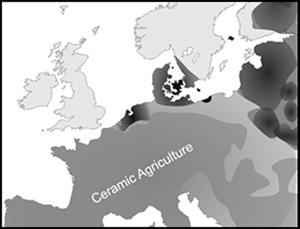Crossref Citations
This article has been cited by the following publications. This list is generated based on data provided by
Crossref.
Admiraal, Marjolein
Lucquin, Alexandre
von Tersch, Matthew
Craig, Oliver E.
and
Jordan, Peter D.
2020.
The adoption of pottery on Kodiak Island: Insights from organic residue analysis.
Quaternary International,
Vol. 554,
Issue. ,
p.
128.
Nyland, Astrid J.
Walker, James
and
Warren, Graeme
2021.
Evidence of the Storegga Tsunami 8200 BP? An Archaeological Review of Impact After a Large-Scale Marine Event in Mesolithic Northern Europe.
Frontiers in Earth Science,
Vol. 9,
Issue. ,
Menne, Julia
and
Brunner, Mirco
2021.
Transition from Swifterbant to Funnelbeaker: A Bayesian Chronological Model.
Open Archaeology,
Vol. 7,
Issue. 1,
p.
1235.
Martínez Sánchez, Rafael M.
Rodríguez, Juan Carlos Vera
Caro, Jesús Gámiz
Pardo-Gordó, Salvador
Pérez-Jordà, Guillem
and
Peña-Chocarro, Leonor
2021.
Reflections on the Other Side. A Southern Iberia Origin for the First Pottery Production of Northern Morocco?.
Open Archaeology,
Vol. 7,
Issue. 1,
p.
1054.
Craig, Oliver E.
2021.
Prehistoric Fermentation, Delayed-Return Economies, and the Adoption of Pottery Technology.
Current Anthropology,
Vol. 62,
Issue. S24,
p.
S233.
Thomas, Julian
2022.
Neolithization and Population Replacement in Britain: An Alternative View.
Cambridge Archaeological Journal,
Vol. 32,
Issue. 3,
p.
507.
Lawrence, Tom
Donnelly, Mike
Kennard, Liz
Souday, Caroline
and
Grant, Rose
2022.
Britain In or Out of Europe During the Late Mesolithic? A New Perspective of the Mesolithic–Neolithic Transition.
Open Archaeology,
Vol. 8,
Issue. 1,
p.
550.
Little, Aimée
Needham, Andy
Langley, Andrew
and
Elliott, Benjamin
2023.
Material and Sensory Experiences of Mesolithic Resinous Substances.
Cambridge Archaeological Journal,
Vol. 33,
Issue. 2,
p.
217.
Jørgensen, Erlend Kirkeng
Arntzen, Johan Eilertsen
Skandfer, Marianne
Llewellin, Madison
Isaksson, Sven
and
Jordan, Peter
2023.
Source-sink dynamics drove punctuated adoption of early pottery in Arctic Europe under diverging socioecological conditions.
Quaternary Science Reviews,
Vol. 299,
Issue. ,
p.
107825.
Varadzin, Ladislav
Varadzinová, Lenka
D’Ercole, Giulia
and
Garcea, Elena A. A.
2024.
Early Pottery Technologies among Foragers in Global Perspective.
p.
1.
Heimann, Robert B.
2024.
Ancient and historical cooking pots and food: an eternal communion. A topical review.
Archaeometry,
Cooney, Gabriel
O’Neill, Brendan
Revell, Martha
Gilhooly, Bernard
and
Knutson, Rachael
2024.
A special source: making porphyritic andesite axeheads at the Eagle’s Nest, Lambay, Ireland in the Early Neolithic.
World Archaeology,
p.
1.
